Trail Tale
By Guy De Galard
Photographs by Dan Bryant and Craig Buck
Saddle up with Troop 466 for a weeklong cattle drive along the legendary Chisholm Trail.
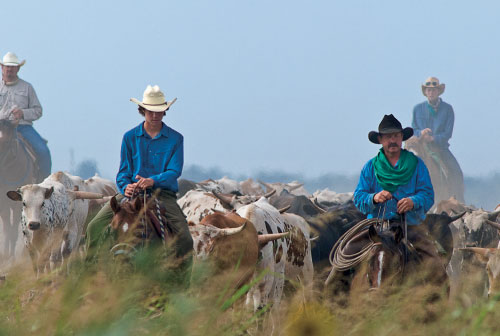 Earning Their Spurs: Assistant Scoutmaster Keith Shukait, First Class Scout Spencer Rodrigues, and Life Scout Kevin Hayes (from left) on the trail to Bison, Okla., with drover Roger Shire (with green bandana) in the lead. |
At breakfast, trail boss Gary Townsend handed each of the 13 Scouts a buckeye. “This will bring you luck today,” he told the boys, “and you won’t get hurt if your horse goes down.”
If your horse goes down?
It was four days into Troop 466’s weeklong cattle drive on the legendary Chisholm Trail. Still, the suburban teens weren’t sure what to make of what they heard—even though the veteran cowhands had warned them that crossing Oklahoma’s Cimarron River could be dangerous. Townsend warned them, too.
Quicksand had swallowed up the trail boss’ horse to its belly the week before the Scouts and five adult leaders arrived from Sunnyvale, Calif. “I’ve been crossing the river for years,” Townsend said, “and I’ve never seen it so bad as this summer.”
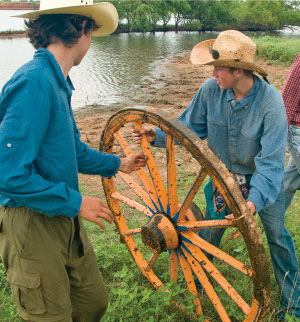 First Class Scout Spencer Rodrigues (left) and Life Scout Kevin Hayes soak the chuck wagon's dried-out wheel in a pond. |
That morning, after long days of adjusting to the worst heat of the 21st century, getting to know their horses, learning basic cowboy skills, and driving a herd of 76 Longhorn steers, the boys faced their first big challenge. Just like the 19th-century cowboys on their two-month cattle drives from South Texas to Abilene, Kan., the group was going to ford a river.
During summer months, the Cimarron doesn’t look dangerous. The water is only about a foot deep. But the drovers knew better. “And they were nervous,” said Tad Malone, the son of Troop 466’s assistant Scoutmaster Mike Malone. “That’s why, beginning at breakfast and continuing right to the edge of the river, they lectured us on safety.”
The message: When you start to cross, don’t stop.
Then it was time to head out. The working cowboys and the novice cowboys mounted up and rode single file across wildflower-covered terrain where prairie grass grew as high as their saddles. The party stopped on the muddy south bank to survey the river from a wide sandbar.
“I was focused on the river, getting up the nerve to ride,” Tad recalled. “It was hard to ignore my growing sense of foreboding.”
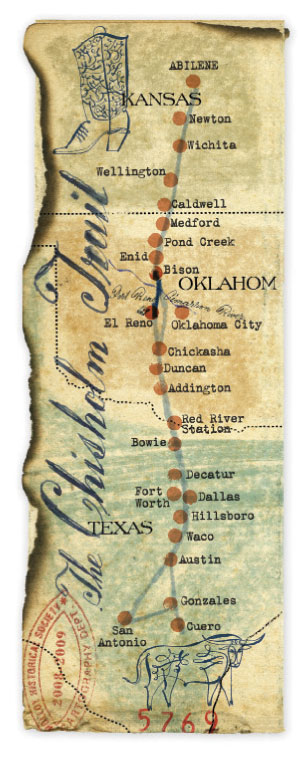 As Townsend instructed the group one last time to keep moving during the cross and not to pull on the reins if the horse went down, riders appeared on the opposite bank—along with a couple of crews from local TV stations that had come out to record the action.
As Townsend instructed the group one last time to keep moving during the cross and not to pull on the reins if the horse went down, riders appeared on the opposite bank—along with a couple of crews from local TV stations that had come out to record the action.
Suddenly, two young riders broke off, descended the steep bank, spurred their mounts, and started to cross. Troop members watched them come, holding their breath and expecting to see the riders’ horses plunge into quicksand at any moment. Instead, the pair crossed safety, pulled up near the waiting boys, and Townsend introduced them as his niece and nephew.
That was just what the Scouts needed to gain confidence. “If they can do it,” shouted 16-year-old Varun Cidambi, “we can do it!”
Townsend began leading the boys across in groups of twos and threes—making sure to ride back and forth in the tracks of his own horse. When it was Tad’s turn, the Eagle Scout galloped into the water, kicking his horse and yelling, “Don’t stop! Don’t stop! Don’t stop!”
His mount stumbled twice. He lost his hat. But in a loud racket of splashing and shouting, Tad charged forward and reached the opposite bank in just a few more strides. “I was hunched over the horse’s neck and whipping it with my reins,” he said later. “We hit the bank and clambered up a 45-degree slope. When we reached level ground, I was cheering at the top of my lungs.”
“That was just an amazing experience,” added 14-year-old Brandon Hayes. “Everyday life for me is usually television and video games. That was just so different—a once-in-a-lifetime experience.”
You don’t need to travel far to have a once-in-a-lifetime experience. Ask Mike Malone, who “every year concocts an even more ambitious—some would say, insane—Boy Scout project than the year before,” his son said, laughing.
A couple of years ago, Malone took members of Troop 466 on a 192-mile hike across England to the World Jamboree. But planning for last summer’s trip, the 54-year-old Scout leader wanted to find another unique experience the boys would remember for the rest of their lives, “but without having to travel halfway across the world.”
Malone hit on the idea of taking some of the older Scouts on a 50-mile cattle drive between two small Oklahoma towns: El Reno and Bison. It would follow as closely as possible the original route of the old Chisholm Trail along modern-day Highway 81. And besides giving the group a taste of what life was like on a 19th-century cattle drive, Malone also intended to put the Scouts to work.
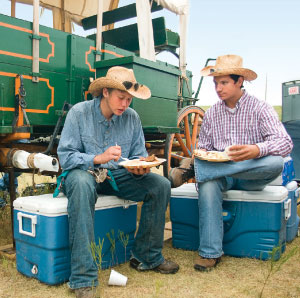 Coolers beside the chuck wagon add to the dining experience of Life Scouts Kevin Hayes (left) and Michael Serio after a hard day's ride. |
The Omnibus Public Land Management Act of 2009, signed into law by President Barack Obama in late March, directs the Secretary of the Interior to consider designating the Chisholm Trail a National Historic Trail. Scouts on the drive, led by Eagle candidate Zack Shukait, helped pave the way for that designation by clearing brush, repainting markers, and helping restore parts of the trail in preparation for a BSA Historic Trails certification, patch, and medal—the second Historic Trails medal earned by Troop 466.
“My goal is to work with the Eagle candidates to seed these historic trail projects all over the Western United States,” Malone explained.
Perhaps family ties also lured him. Malone, a noted technology journalist and author, is presently restoring his family’s historic Oklahoma Land Rush homestead outside of Bison, Okla.
“I had always known that my great-grandfather had been part of the Cherokee Strip Land Run of 1893. But it was only in preparing for this cattle drive that I discovered that he had also surveyed the Chisholm Trail for the railroad three years before that. I realized then I would be riding along the same path he had walked more than century before. So, for me, this was a trail ride into the past.”
Scouts learned that history on their visit to the Chisholm Trail Heritage Center in Duncan, Okla. Millions of cattle were driven the trail’s 1,200-mile length, from Texas to the Kansas Pacific Railway railhead in Abilene, for just 20 years (1867-1887). But as museum coordinator Cova Williams explained, “It was named after someone who never herded cattle.”
That someone was Jesse Chisholm, a merchant of Cherokee and Scottish descent who frequently traded with the Indians in south-central Oklahoma. When the Civil War broke out, Chisholm moved to a site near present-day Wichita, Kan. But because of his dealings with the Indians, he had become acquainted with the route.
After the Civil War, when Texas cowboys began rounding up free-range cattle and driving them to feed the teeming city populations of the North, they took Jesse Chisholm’s trail.
The coming of the settlements and barbed-wire fences eventually rendered the trail difficult to use. And the extension of the railroads into Texas made it unnecessary. Chisholm died in 1868 before the great days of the cattle drives and without knowing his name would be so closely associated with the history of the Old West.
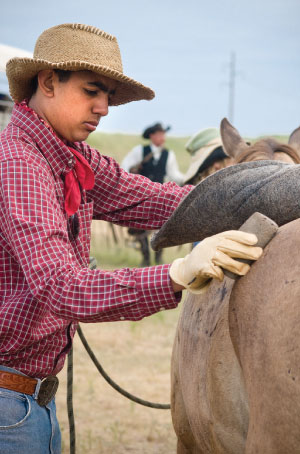 Life Scout Varun Cidambi grooms his horse outside Hennessey, Okla., before the start of the drive. |
Troop 466 started its weeklong ride with dinner—indoors, not outdoors, at the historic Cattlemen’s Steakhouse in Oklahoma City’s stockyards. That night, the boys spread their bedrolls on the grass at a nearby campsite and tried to get a good night’s sleep despite the heat, the humidity, and the insects. Too early, for some, the whinnying of horses and sounds of the animals chewing their morning feed served as an alarm clock long before dawn.
After a chuck-wagon breakfast of bacon, eggs, and biscuits drenched in gravy, troop members traded their Scout uniforms for jeans, boots, and newly acquired straw cowboy hats. All except 14-year-old Brandon Hayes. A fan of City Slickers, Brandon donned a New York Mets cap like the one worn by Billy Crystal’s character in the film. The drovers teased him about it for the rest of the week, but the boy refused to take it off.
Trail boss Townsend, a friendlier version of Jack Palance, prepared them for their first day, offering instructions on what to do if bitten by a snake and how to stay hydrated. Along with Jerrica Lockwood, a local rancher who helped organize the Oklahoma Centennial Cattle Drive in 2007, he helped match the Scouts and leaders with horses according to their size and riding ability. The mounts, said Lockwood, were chosen to give the group some well-broken, stout ranch horses experienced at herding cattle long distances.
Oklahoma Lt. Gov. Jari Askins dropped by to give the drive a formal send-off. And after a final check of stirrups and cinches, the drovers pointed the herd north.
Head ’em up, move ’em out!
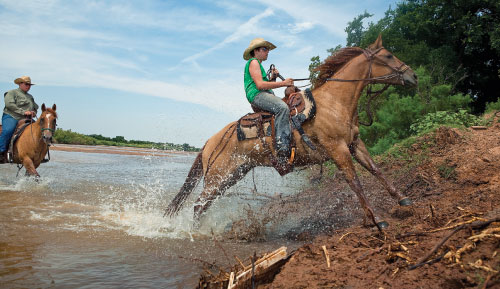 Life Scouts Lucas Sloan (left) and Tom Brubaker gallop across the Cimarron River. |
Hours passed. Days passed. Though the mornings were relatively cool, temperatures rose as high as 107 degrees and an estimated 140 degrees on the streets where they rode. Ice packs wrapped inside bandanas and tied around the necks of the sun-baked riders melted fast. Some Scouts ran out of water after drinking the liters of it they carried in their backpacks.
By the time the riders reached the small farming community of Kingfisher, they sat not so tall in the saddle. Dust caked their faces. Shirts clung to their sweaty backs. Sore muscles needed massaging.
Citizens gathered to watch the peculiar group pass through town. Tad Malone noticed that the horses’ hooves left indentations in the heat-softened asphalt. But Kingfisher offered lunch, gallons of iced Gatorade, blissful (if temporary) air conditioning, and an imposing statue of Jesse Chisholm.
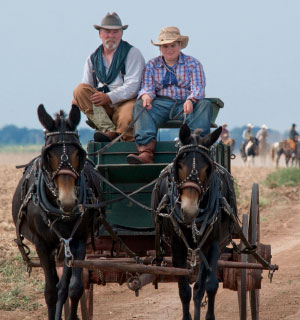 Cowboy Keith Hawkins (left) teaches Star Scout Michael Goldman how to handle a mule cart. |
As they continued the daylong ride, the Scouts got acquainted with their mounts—some more quickly than others. Those with experience dared break into a trot, soon followed by a “Whoa!” The drovers, amused but impressed by the gains the boys made in confidence, offered pointers on how to improve the boys’ skills.
When the group reached camp early that afternoon, the Scouts and Scouters found welcome shade in a clump of trees near a small watering hole. At the pond to water his horse, Varun Cidambi’s ever temperamental mount went in too deep. Struggling and thrashing to get out of the mud and regain its footing, the horse lunged forward and pitched the boy into the water.
Shook up and a little embarrassed, but unhurt, Cidambi later laughed about his “cowboy experience.” “I didn’t know what to do, and the next thing I knew, I was on the ground,” said Varun, his pants covered with mud. “I didn’t know how to ride, but I took a few lessons before I came. I’ve found the best way to learn is to just experience it.”
Which summed up the primary motivation for many of the Scouts to join the drive. “I never rode a horse before,” said 16-year-old Andrew Bautista, “and I wanted to learn something new.”
As the days went by, the boys and leaders found their new skills becoming second nature. Everyone began taking pride in their horses, brushing, petting, and talking to them while the animals ate. And the camaraderie between the boys grew, too. They began using the nicknames given them by the drovers: Worm, Blister, Hollywood, Peaches, Slats, Smiley, Woo, and, of course, Mud. And they learned to work together as a team.
By Friday, the boys were ready to test their newfound skills. In Bison, Scouts covered their faces with bandanas and turned out a large corral full of longhorns into a nearby meadow. Two boys on horseback entered the corral and nudged the cattle out. As some of the critters broke free from the herd, the boys moved quickly to hustle them back.
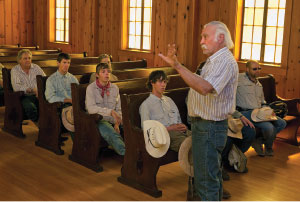 Robert K. Warren, visitor center director, discusses the history of Fort Reno in the outpost's chapel. |
Dust flew. Whips cracked. It was chaos at first. But the Scouts began coordinating their moves and communicating with one another using as few words as possible.
Brandon Hayes, nicknamed “Custer” because of a mop of blond hair that stuck out from under his Mets cap, even sang to the longhorns to settle them down. “It actually worked!” he yelled.
The group herded the cattle across a gravel road and cut across an open pasture, making the activity even more realistic. Exhilarated, the Scouts shared their feelings about the experience.
“I now understand what it must have been like to drive cattle on the Chisholm Trail, over miles of open range,” enthused William “Wild Bill” Holt, 17.
Added Tad Malone: “It makes me feel proud to be part of history.”
During their week on the trail, the boys and leaders also visited Fort Reno in El Reno, Okla., a military outpost established in 1874 to help quell unrest in that part of Indian Territory. Their evening activities featured demonstrations by members of the Bowhunting Council of Oklahoma, Cheyenne Chief Francis Deer, who showed them how to set up a tipi, and American Indian dancers who taught the boys to perform traditional interpretations of acts of bravery.
Townsend, Lockwood, and legendary cattle driver Ron Green, Lockwood’s dad, gave the boys lessons in a variety of cowboy skills: saddling, tying lead ropes, setting up a picket line for the horses. The kids even took part in a local rodeo, branding calves, bulldogging, and riding a mechanical bull.
They also listened to many tales of the Old West, which impressed Senior Patrol Leader Thomas Brubaker. The boy had joined the cattle drive because he was completing an Eagle Scout project that included creating a Web site about the trail, designing the historic medal, and writing an education pamphlet to distribute to museums in Oklahoma.
“I thought it was only in the Westerns I’ve seen,” said the wide-eyed 17-year-old, “shoot-’em-up cowboy movies, roping cattle, and all that.”
The weeklong ride symbolically ended in the meadow outside Bison, where the Land Rush began. And though toughened by the hardships of the ride, each Scout still hated to part with at least one of his Chisholm Trail companions: his horse.
“We spent a few moments talking quietly to our horses, patting them and thanking them,” Tad said. “It was a surprisingly heartfelt moment.”
And it seemed clear to the leaders that the Scouts had earned their spurs. “I was concerned because several of these boys had absolutely no experience,” Lockwood said. “But they learned fast. I’m so proud of them. They actually look like they belong out here.”
Most of all, they learned something about themselves, Mike Malone said. “I think they discovered that they’re tougher than they thought.”
Guy De Galard has written articles for Cowboys & Indians and Western Horseman magazines.
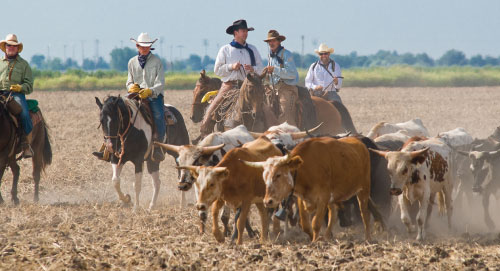 Tending the herd (from left) former Troop 466 Scoutmaster Chris Early, Life Scout Zack Shukait, cowboy Dusty Bittle, drive master Ron Green, and dad Robert Sloan. |
Chisholm Trail Facts• Beef had become so popular in the East after the Civil War that one steer could sell for as much as $50—that’s more than $700 today after adjusting for inflation. • One of Jesse Chisholm’s trading posts was located at the present site of the Twin Lakes Shopping Center in Wichita, Kan. • Joseph G. McCoy, a cattle-buyer from Illinois, built stock pens in Abilene, Kan., in 1867 and that year shipped 35,000 head back East. • O.W. Wheeler drove the Chisholm Trail’s first steers from San Antonio, Tex., to Abilene, Kan., in 1867. • The earliest newspaper reference to the Chisholm Trail appeared in the Kansas Daily Commonwealth on May 27, 1870. • Cattle did not actually follow a “trail,” except at river crossings; they spread out to graze. • Driving 2,500 head of cattle generally required 10 cowboys, as well as a trail boss, a cook, and a horse wrangler. • In 1872, more than 5,000 cowboys got paid in a single day in Abilene. • In 1884, a trailing contractor delivered 45,000 head of cattle in 15 separate herds for an annual net profit of $20,000—roughly $475,000 in 2009 dollars. • By 1885, when the Chisholm Trail was closed by settlement and barbed wire, an estimated 5 million cattle and 1 million mustangs had traveled the trail. |
If You GoChisholm Trail Heritage Center: View a film in the Chisholm Trail Experience Theater, take in art at the Garis Gallery of the American West, and admire Paul Moore’s “On the Chisholm Trail,” a life-size, bronze sculpture of cowboys, longhorns, and horses—even a dog. Admission: adults, $6; kids (5-17), $4. Hours: 10 a.m.-5 p.m. Monday-Saturday and 1-5 p.m. Sunday. 1000 Chisholm Trail Parkway, Duncan, Okla.; 580-252-6692, onthechisholmtrail.com. Cattlemen’s Steakhouse: Chow down at this historic Western eatery, where you’ll rub elbows with working cattlemen, wealthy wildcatters, and a bunch of curious visitors just like you. In between bites of the Midwest-raised, corn-fed beef, gaze up at the framed photos of real-life cowboys—and some from Hollywood—that cover the walls. Hours: 6 a.m.-10 p.m. Sunday-Thursday and 6 a.m.-midnight Friday and Saturday 1309 S. Agnew, Oklahoma City, Okla.; 405-236-0416, cattlemensrestaurant.com. Fort Reno: Relive the Old West in historic artifacts, photographs, and art by famed painter Frederic Remington. Then, tour 25 restored buildings at this historically significant 19th-century Army outpost, including an 1876 officer’s quarters, 1878 bakery, and 1887 guardhouse. Admission: free. Hours: |